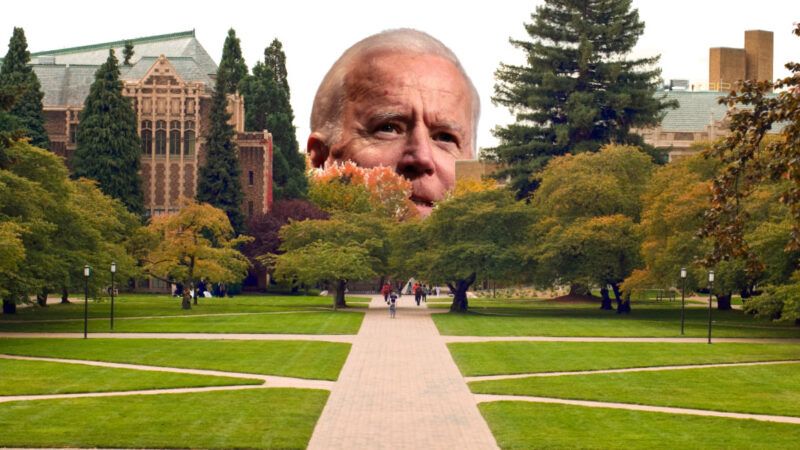Biden's Loan Forgiveness Plan Ultimately Means Higher Costs for Higher Ed
If political pressure to forgive debt can work once, why wouldn't it work again every five or 10 years?

When President Joe Biden announced in August that he was canceling thousands of dollars in student loan debt for most current borrowers, he explained that his plan was partly a response to the rapid rise in the cost of higher education.
"Here's the deal," Biden said. "The cost of education beyond high school has gone up significantly. The total cost to attend a public four-year university has….nearly tripled in 40 years—tripled." Education, Biden insisted, is the "ticket to a better life." Yet thanks to rapidly increasing costs, "that ticket has become too expensive for too many Americans."
It is true that the cost of higher education has risen markedly in the last four decades. It is also true that as costs have risen, so has the number of graduates with loans. Prior to Biden's forgiveness plan, there was $1.6 trillion in outstanding student loan debt, up from about $187 billion in 1995. But Biden's plan not only fails to address any of the factors driving those cost increases; it is nearly certain to make the problem worse.
One reason colleges have continued to raise tuition prices and fees is that the federal government has enabled them to do so by backstopping student loans. In 2010, as part of the Obamacare reconciliation package, the federal government effectively took over the student loan market in its entirety.
The widespread availability of student aid has provided financial assistance to millions of student borrowers. But it also has given colleges a larger pool of money from which to draw. As loans have become more common and more generous, colleges have built elaborate, sometimes luxurious facilities and hired armies of administrative staff, often with quite generous salaries. Although it may seem like a paradox, the expansion of student financial aid has made college more expensive.
Biden's student loan forgiveness plan is apt to have the same effect. It will cancel up to $10,000 in federal student debt (or $20,000 for Pell Grant recipients) for individuals making up to $125,000 a year and couples making up to $250,000. That is effectively a subsidy on top of a subsidy. It makes borrowing cheaper by reducing the amount that has to be repaid.
Although the debt forgiveness currently is structured as a one-time action, it is likely to set up the expectation of further cancellations. If political pressure to forgive debt can work once, why wouldn't it work again every five or 10 years?
Biden's student loan program also includes a change to income-driven repayment (IDR) plans, which let borrowers pay back loans based on how much they earn. Starting in 2023, students in IDR plans will have to pay only 5 percent of their annual earnings beyond $33,000. Normally, payments too small to cover the full amount of interest on a loan would increase the amount owed. Under Biden's plan, the government will simply forgive that amount, so that the underlying loan size can never increase. And after 20 years, any remaining amounts will be wiped from the books.
"The changes mean that most undergraduate borrowers will expect to only repay a fraction of the amount they borrow, turning student loans partially into grants," the Brookings Institution's Adam Looney noted. "It's a plan to reduce the cost of college, not by reducing tuition paid, but by offering students loans and then allowing them not to pay them back."
Looney's analysis suggests that the loans will disproportionately benefit "low-quality, low-value, low-earning programs," since the system is based on postgraduate incomes. Borrowers who enroll in programs that don't lead to well-paying jobs will benefit more than students who choose schools and majors that do. The federal government is essentially encouraging students to start down less productive, less lucrative career paths.
Furthermore, since many students will no longer be on the hook for full repayment of their loans, price hikes won't be seen or felt directly, even as the cost of an education grows. Despite his promises, Biden has created a system that will make life worse for some students and make the "ticket to a better life" even more expensive.
